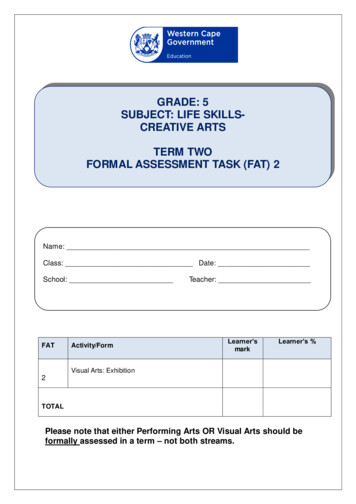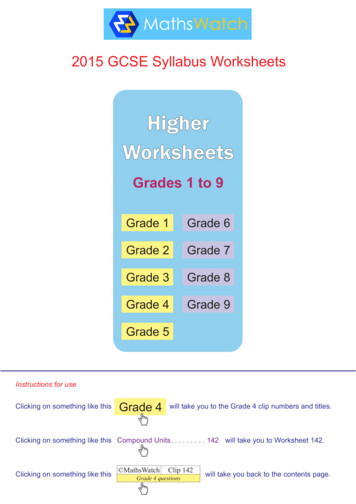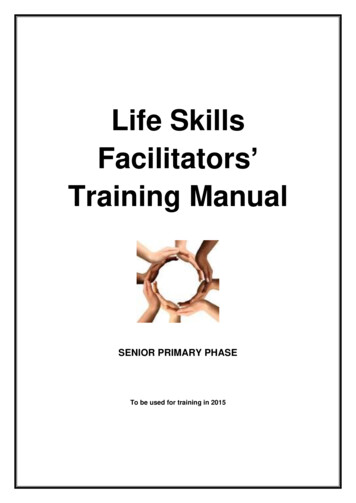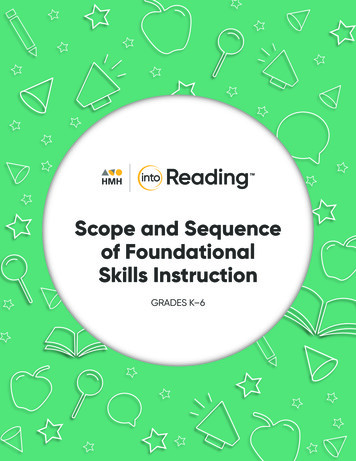
Transcription
GRADE: 5SUBJECT: LIFE SKILLSCREATIVE ARTSTERM TWOFORMAL ASSESSMENT TASK (FAT) 2Name:Class: kLearner’s %Visual Arts: Exhibition2TOTALPlease note that either Performing Arts OR Visual Arts should beformally assessed in a term – not both streams.
LIFE SKILLS: CREATIVE ARTSFORMAL ASSESSMENT TASK: VISUAL ARTSGRADE 5TERM 2NOTE TO THE TEACHER:The Formal Assessment Task has been developed as a step by step guideline to learners.The activities are to be done in class, during the second term. It is important that teachersmediate the various steps of the task with learners to ensure active, creative and criticalparticipation by all learners.ACTIVITY 1:CREATE IN 2D & 3D, CREATIVE LETTERINGAND/OR PATTERNMAKINGART MATERIAL:Sturdy paper, scissors, pencils, black wax crayon or koki, oil pastels or wax crayons, thickcardboard strips, stapler.INSTRUCTIONS:You will be designing and creating a mask incorporatingpatternmaking.In this artwork, youwill use the elements of art called LINE, SHAPE andCOMPLEMENTARY COLOUR and the design principle called BALANCE (SYMMETRICAL /ASYMMETRICAL AND DISPERSION).It is very important to notice the different types of patterns around you in your environmente.g. in nature or in architecture (OBSERVATION). You must concentrate hard and look at allthe unique aspects of the different patterns you see.GR 5: FAT LS – Creative Arts: Visual Arts: Term 21 P a g e
Discuss: With the aid of your teacher explore what you already know of the concepts ofpatternmaking. Look at all the different types of patterns you can see around you. Look at the shapesand forms. How are they shaped? Are they circular, wavy, geometric, etc? Discuss masks and their significance, as well as how pattern is incorporated in theirdesign. It is important for you to visualise your design e.g. a painting is very different from adrawing.Let us practise first: First trace the lines of the different patterns in the air. Now, take a black wax crayon and on an A3 piece ofpaper, begin to draw different patterns. Try to create your own patterns and not just repeat thebasic ones that you may already know or were taught.There is no right or wrong! Just draw! Take your time and draw your patterns slowly and carefully.Now let us start the final artwork: Your teacher will now hand out a new sheet of sturdy paper (A3) that will be lightlyfolded in half.GR 5: FAT LS – Creative Arts: Visual Arts: Term 22 P a g e
Work with a partner to mark the position of your eyes. Drawing around these marks exaggerate the size and create an interesting shape. Cut out the shapes of the eyes. Repeat the process with the nose and mouth. Your lines should be solid. Fold the paper in half and on one side design the edge of the mask. With the paper still folded cut out this shape so that symmetry can be attained. Use the black wax crayon or koki to enhance the facial features of the mask. Make sure that you use most of the page. Be careful not to draw your picture just in acorner of the page. Your drawing must cover the entire page. Your teacher will introduce the concept of pattern as repeated elements. Use pattern to decorate the rest of the mask. Your teacher will show you how to make a headband using strips of thick card andattach it to your mask.Let’s add colour: Your mask is decorated with different types of lines creating patterns; you may havethick, thin, smooth, jagged, little short lines or long smooth lines.GR 5: FAT LS – Creative Arts: Visual Arts: Term 23 P a g e
Once the patterns are completed your teacher will discuss the use of colour in yourartwork, especially complementary colours and how to create balance using colour. Add colour to your picture. Use oil pastels or wax crayons and add the colours that youfeel would suit your mask best. Look again at your mask and add your final touches to ensure that you are satisfied withthe use of colour, line and pattern. Your teacher will display your mask on the wall. Your artwork will be assessed by your teacher who will look at the following aspects of it.GR 5: FAT LS – Creative Arts: Visual Arts: Term 24 P a g e
CRITERIA1-23-45-67-8Able to apply anHas met the criteriaExpressive designhas been appliedThe completed mask is anUnsuccessfulexpressiveto create anexpressive, visually designdesign.design, but needsexpressive designmore guidance.appropriately.Less than 40 % ofBetween 40 - 55Between 55 - 80 %More than 80 % ofBalance: The mask isthe mask is% of the mask isof the mask isthe mask issymmetrical in design.symmetrical insymmetrical insymmetrical insymmetrical indesign.design.design.design.successfully andenhances themask.ExceedsPattern has beensuccessfully utilised.Attempted, but notAble to useHas met the criteriaexpectations andable to use patternpattern. Needsto use patterncriteria to usesuccessfully.more practice.suitably.patternsuccessfully.The art medium has beenwell applied. The learner canuse it in an appropriateInappropriateapplication ofmedium.manner.The learner has expressedhim/herself confidentlyusing the required colourcombination.Attempted toexpresshim/herself, butnot able attain thedesired outcome.Able to usemedium, but notconsistent. Needsmore practice.Able to expresshim/herself in ameaningfulmanner.Needs morepractice.The medium hasHas met the criteriabeen appliedto use mediumcorrectly andappropriately.enhances thepicture.Has met the criteriaExceedsto expressexpectations andhim/herselfcriteria to expressconfidently and in ahim/herselfmeaningful manner.confidently.Subtotals:TOTALGR 5: FAT LS – Creative Arts: Visual Arts: Term 2/405 P a g e
Considering inclusivity: Learners with visual impairment: you could do the same activityusing touch to determine the shape and form of the mask. Textured material like crayonsshould be used when drawing.For learners who experience cognitive barriers, break the activity down in smaller, moremanageable steps. Ensure that all learners have an opportunity to complete all the steps attheir own pace.INTEGRATED LEARNING AND ASSESSMENT STRATEGYThe learning and assessment processes are integrated. Assessment is continuous andformative as the teacher will observe the progress of the learner towards the final art work.The final art work is assessed formally by the teacher by means of a rubric.Activity herClass list (just to beticked off)RubricAssessmentMethodA3 drawing with waxcrayonFinal drawing withcolour /teacherassessmentProcess towards finalmaskClass list (just to beticked off)Formal:SummativeTeacherFinal maskRubric2D drawingActivity 2:AssessmentInstrument3D modelDISTRIBUTION OF COGNITIVE LEVELSREMEMBER ANDUNDERSTANDVisual Arts elements andprinciples: line, shape, andcomplementary colour and thedesign principle called balance(symmetrical / asymmetrical anddispersion)APPLY AND ANALYSEEVALUATE AND CREATEApplication of elements and principlesin 2D and 3D art works. Continuouscritical reflection and application toimprove the art work during class time.Creating and presenting ofthe 2D and 3D art works.(According to the Adapted Blooms’ Taxonomy, 1990)GR 5: FAT LS – Creative Arts: Visual Arts: Term 26 P a g e
design, but needs more guidance. Has met the criteria to create an expressive design appropriately. Expressive design has been applied successfully and enhances the mask. Balance: The mask is symmetrical in design. Less than 40 % of the mask is symmetrical in design. Between 40 - 55 % of the mask is symmetrical in design. Between 55 - 80 %











